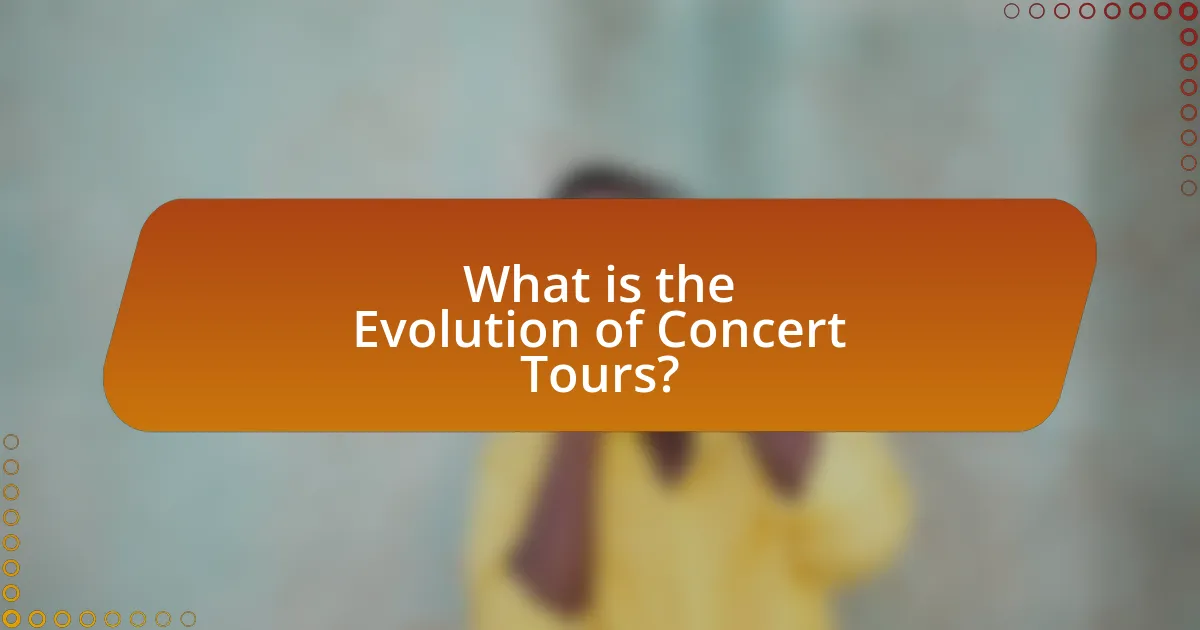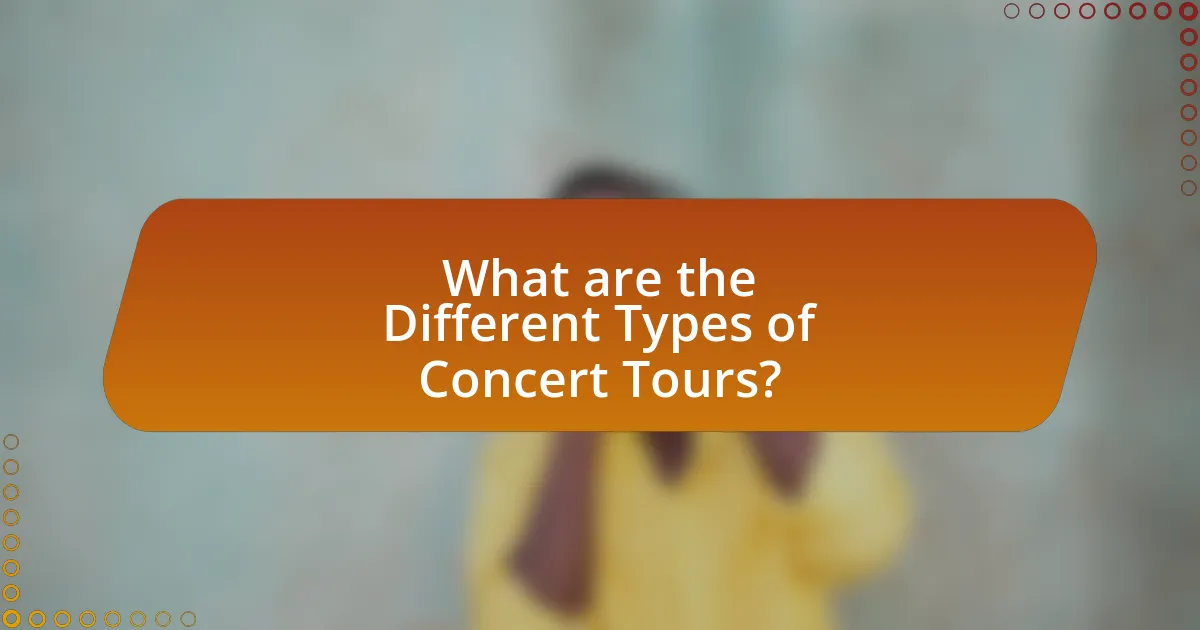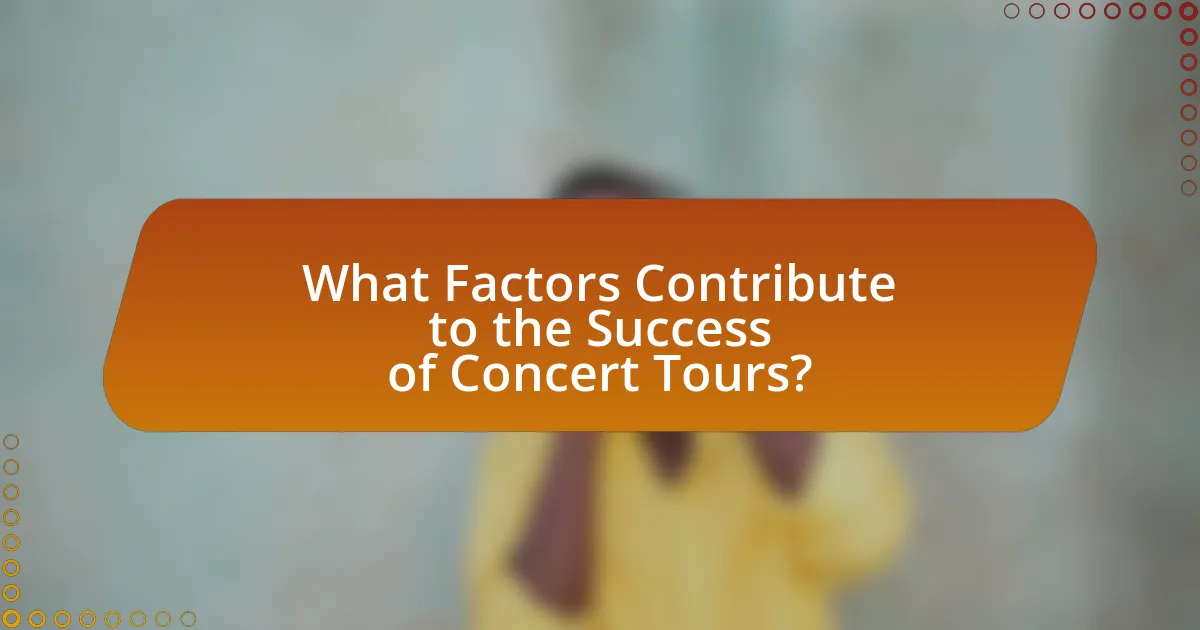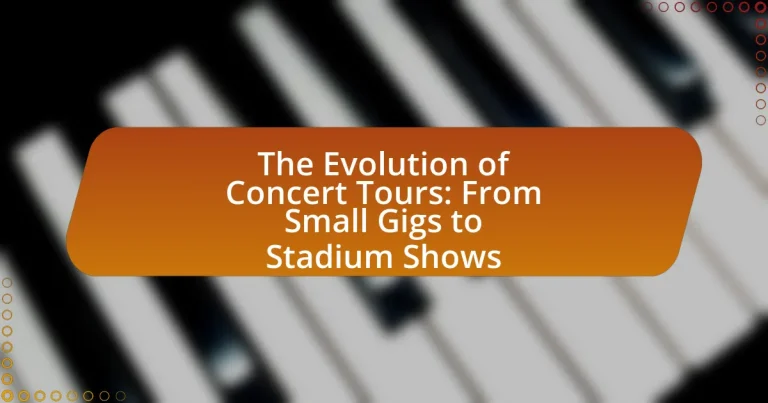The article examines the evolution of concert tours, tracing their development from small, localized performances in the early 20th century to large-scale stadium shows today. It highlights key technological advancements, such as electric amplification and digital marketing, that have transformed the concert landscape, enabling artists to reach wider audiences and generate significant revenue. The article also discusses the various types of concert tours, the impact of fan engagement, and the economic benefits to local communities, while exploring future trends in the industry, including sustainability and immersive experiences through technology. Overall, it underscores the critical role concert tours play in the music industry and the factors contributing to their success.

What is the Evolution of Concert Tours?
The evolution of concert tours has transitioned from small, localized performances to large-scale stadium shows. Initially, in the early 20th century, concerts were often held in intimate venues, such as community halls and small theaters, where artists performed for limited audiences. As technology advanced, particularly with the introduction of electric amplification in the 1930s, artists began to reach larger crowds, leading to the rise of arena concerts in the 1960s and 1970s.
By the 1980s and 1990s, concert tours became major commercial enterprises, with elaborate stage designs and extensive marketing strategies. The introduction of large-scale festivals, such as Woodstock in 1969 and Coachella in the late 1990s, further transformed the concert landscape, allowing multiple artists to perform simultaneously and attracting massive audiences.
Today, concert tours are often global events, with artists like Taylor Swift and Ed Sheeran grossing hundreds of millions of dollars per tour, reflecting the significant financial investment and production value involved. This evolution highlights the changing dynamics of live music, driven by technological advancements, cultural shifts, and the growing demand for immersive experiences.
How have concert tours changed over the decades?
Concert tours have evolved significantly over the decades, transitioning from small, localized performances to large-scale, global events. In the 1960s and 1970s, artists typically performed in smaller venues, often relying on word-of-mouth and local radio for promotion. By the 1980s and 1990s, advancements in technology, such as improved sound systems and lighting, allowed for larger venues and more elaborate stage productions. The introduction of ticketing platforms and online marketing in the 2000s further transformed concert tours, enabling artists to reach wider audiences and sell tickets more efficiently. Today, major tours often feature extensive production budgets, sponsorship deals, and global marketing strategies, with artists like Taylor Swift and Ed Sheeran grossing hundreds of millions of dollars per tour, reflecting the commercial scale and complexity of modern concert tours.
What were the characteristics of early concert tours?
Early concert tours were characterized by smaller venues, limited technology, and a focus on regional audiences. These tours often featured local artists or bands performing in intimate settings such as clubs, theaters, and community halls, which allowed for direct interaction with fans. The absence of advanced sound systems meant that performances relied heavily on the natural acoustics of the venue and the musicians’ vocal and instrumental skills. Additionally, early concert tours typically had shorter durations and fewer stops, often focusing on a single geographic area, which facilitated a close-knit community atmosphere among performers and audiences.
How did technological advancements influence concert tours?
Technological advancements significantly influenced concert tours by enhancing production quality, improving audience engagement, and expanding reach. Innovations such as advanced sound systems, high-definition video screens, and sophisticated lighting effects have transformed live performances into immersive experiences. For instance, the introduction of digital audio technology in the 1980s allowed for clearer sound reproduction, which became a standard in large venues. Additionally, the rise of social media and streaming platforms has enabled artists to promote their tours more effectively and connect with fans globally, increasing ticket sales and attendance. According to a report by Pollstar, the global concert industry generated over $30 billion in revenue in 2019, showcasing the impact of these technological improvements on the scale and success of concert tours.
Why are concert tours significant in the music industry?
Concert tours are significant in the music industry because they serve as primary revenue sources for artists and promote their music directly to fans. In 2019, live music generated approximately $27 billion in revenue in the United States alone, highlighting the financial importance of tours. Additionally, concert tours enhance an artist’s visibility and brand, allowing them to connect with audiences on a personal level, which can lead to increased album sales and streaming numbers. The combination of these factors underscores the critical role that concert tours play in the overall success and sustainability of artists within the music industry.
What role do concert tours play in an artist’s career?
Concert tours are essential for an artist’s career as they provide a primary source of income, enhance visibility, and foster a deeper connection with fans. Through live performances, artists can generate significant revenue, often surpassing earnings from album sales and streaming. For instance, in 2019, the global concert industry generated approximately $26 billion, highlighting the financial importance of tours. Additionally, concert tours allow artists to showcase their music in a live setting, which can lead to increased album sales and streaming numbers post-tour. This direct interaction with audiences strengthens fan loyalty and engagement, making tours a critical component of an artist’s overall success and longevity in the music industry.
How do concert tours impact local economies?
Concert tours significantly boost local economies by generating revenue through increased tourism, hospitality, and retail spending. For instance, a study by the National Endowment for the Arts found that concerts can attract thousands of attendees, leading to heightened demand for hotels, restaurants, and local attractions. In cities hosting major tours, economic activity can increase by millions of dollars; for example, a single concert can generate an estimated $1.5 million in local spending. This influx of visitors not only supports jobs in the service sector but also stimulates long-term economic growth by enhancing the city’s cultural profile and attracting future events.

What are the Different Types of Concert Tours?
There are several different types of concert tours, including promotional tours, festival tours, and world tours. Promotional tours are designed to support the release of a new album, where artists perform in various locations to generate interest and sales. Festival tours involve artists performing at multiple music festivals, often sharing the stage with other acts, which can enhance visibility and audience reach. World tours encompass extensive travel across multiple countries, allowing artists to reach a global audience and often featuring elaborate stage productions. Each type of tour serves specific marketing and engagement purposes, contributing to the overall success of the artist’s career.
How do small gigs differ from large stadium shows?
Small gigs differ from large stadium shows primarily in scale, intimacy, and production value. Small gigs typically feature fewer attendees, often ranging from a handful to a few hundred, allowing for a more personal connection between the artist and the audience. In contrast, large stadium shows can accommodate thousands, creating a more impersonal experience where the focus shifts to spectacle rather than intimacy.
Production value also varies significantly; small gigs often have minimal staging and equipment, while large stadium shows invest heavily in elaborate setups, lighting, and sound systems to enhance the overall experience. For example, major artists like Taylor Swift and U2 utilize advanced technology and large-scale visuals in stadium performances, which are not feasible in smaller venues. This distinction highlights how the environment and audience engagement differ fundamentally between the two types of performances.
What are the advantages of performing in smaller venues?
Performing in smaller venues offers several advantages, including enhanced audience engagement and a more intimate atmosphere. Smaller venues allow artists to connect directly with their audience, fostering a sense of community and personal interaction that is often lost in larger settings. This intimacy can lead to a more memorable experience for both the performer and the audience, as artists can observe and respond to audience reactions in real-time. Additionally, smaller venues typically have lower overhead costs, enabling artists to retain a higher percentage of ticket sales and merchandise revenue. According to a study by the National Endowment for the Arts, smaller venues often provide a platform for emerging artists to gain exposure and build a loyal fan base, which is crucial for long-term career development.
What challenges do artists face in large stadium performances?
Artists face several challenges in large stadium performances, including sound quality, audience engagement, and logistical complexities. The vast size of stadiums can lead to sound delays and inconsistencies, making it difficult for performers to deliver a cohesive auditory experience. Additionally, engaging a large audience, often numbering in the tens of thousands, requires different strategies compared to smaller venues, where personal connection is more feasible. Logistically, managing stage setup, equipment transportation, and coordinating with a larger crew adds layers of complexity that can impact performance quality. These challenges are well-documented in industry reports, highlighting the need for advanced technology and planning to ensure successful large-scale events.
What are the various formats of concert tours?
Various formats of concert tours include arena tours, stadium tours, club tours, festival tours, and virtual tours. Arena tours typically feature performances in large indoor venues, accommodating thousands of fans, while stadium tours take place in even larger outdoor venues, often attracting tens of thousands. Club tours focus on smaller, more intimate venues, allowing for closer interaction between artists and audiences. Festival tours involve artists performing at multiple music festivals, often as part of a larger lineup. Virtual tours utilize digital platforms to reach audiences online, especially popularized during the COVID-19 pandemic, allowing artists to perform live from remote locations. Each format caters to different audience sizes and experiences, reflecting the evolving landscape of live music events.
How do festival tours compare to solo artist tours?
Festival tours typically feature multiple artists performing over a short period, while solo artist tours focus on a single performer showcasing their work over an extended timeframe. Festival tours allow for diverse musical experiences and attract larger crowds, as seen in events like Coachella, which draws over 250,000 attendees annually. In contrast, solo artist tours, such as Taylor Swift’s “Reputation Stadium Tour,” emphasize a cohesive narrative and deeper engagement with fans, often resulting in higher ticket sales per show. The differences highlight varying audience experiences and marketing strategies in the music industry.
What is the significance of themed tours in the music industry?
The significance of themed tours in the music industry lies in their ability to create a unique and immersive experience for fans, enhancing audience engagement and loyalty. Themed tours often incorporate specific narratives, visuals, and setlists that resonate with the artist’s brand or a particular album, making the concert more memorable. For example, Beyoncé’s “The Formation World Tour” not only showcased her music but also addressed social issues, creating a deeper connection with the audience. This approach can lead to increased ticket sales and merchandise revenue, as fans are more likely to invest in an experience that feels personalized and significant. Additionally, themed tours can generate extensive media coverage and social media buzz, further amplifying the artist’s reach and influence within the industry.

What Factors Contribute to the Success of Concert Tours?
The success of concert tours is primarily influenced by factors such as artist popularity, effective marketing strategies, venue selection, and audience engagement. Artist popularity drives ticket sales, as established artists tend to attract larger crowds; for instance, Taylor Swift’s “Reputation Stadium Tour” grossed over $345 million, showcasing the impact of a well-known artist. Effective marketing strategies, including social media promotion and partnerships with brands, enhance visibility and reach, as seen in the promotional efforts for Ed Sheeran’s tours, which utilized extensive online campaigns. Venue selection is crucial, as choosing locations that resonate with the target audience can maximize attendance; for example, the choice of iconic stadiums for major acts often leads to sold-out shows. Lastly, audience engagement through interactive experiences and memorable performances fosters loyalty and encourages repeat attendance, evidenced by the high demand for live shows from artists like Beyoncé, who consistently delivers captivating performances.
How does marketing influence concert tour attendance?
Marketing significantly influences concert tour attendance by creating awareness, generating excitement, and driving ticket sales. Effective marketing strategies, such as targeted advertising, social media engagement, and promotional partnerships, enhance visibility and attract potential attendees. For instance, a study by the International Journal of Arts Management found that social media campaigns can increase ticket sales by up to 30% when artists actively engage with fans online. Additionally, well-timed promotions and collaborations with influencers can create a sense of urgency, further boosting attendance.
What strategies are effective in promoting concert tours?
Effective strategies for promoting concert tours include leveraging social media marketing, collaborating with influencers, and utilizing targeted advertising. Social media platforms like Instagram and Facebook allow artists to engage directly with fans, share tour updates, and create buzz around events. Collaborating with influencers can amplify reach, as they can introduce the tour to their followers, increasing visibility. Targeted advertising, particularly through platforms like Google Ads and Facebook Ads, enables promoters to reach specific demographics based on interests and location, ensuring that promotional efforts are directed toward potential concert-goers. These strategies have been validated by numerous successful concert tours that have utilized them to achieve sold-out shows and increased ticket sales.
How do social media platforms enhance tour visibility?
Social media platforms enhance tour visibility by providing artists and promoters with tools to reach a broader audience quickly and effectively. These platforms allow for targeted advertising, enabling users to promote tours to specific demographics based on interests, location, and behavior. For instance, Facebook’s advertising system can reach millions of users, increasing the likelihood of ticket sales and engagement. Additionally, social media facilitates real-time interaction between artists and fans, creating buzz through shares, likes, and comments, which can lead to viral marketing effects. According to a study by Eventbrite, 93% of event organizers use social media to promote their events, highlighting its critical role in enhancing visibility.
What role does fan engagement play in concert tours?
Fan engagement plays a crucial role in concert tours by enhancing the overall experience for attendees and driving ticket sales. Engaged fans are more likely to attend concerts, purchase merchandise, and promote events through word-of-mouth and social media, which can significantly increase a tour’s visibility and profitability. For instance, a study by Eventbrite found that 78% of concertgoers are more likely to attend a show if they feel a personal connection to the artist, demonstrating that emotional investment translates into higher attendance rates. Additionally, interactive elements such as meet-and-greets, fan voting on setlists, and social media interactions foster a sense of community, further solidifying fan loyalty and encouraging repeat attendance at future tours.
How can artists create memorable experiences for their audience?
Artists can create memorable experiences for their audience by engaging them through immersive performances that combine visual elements, storytelling, and audience interaction. For instance, incorporating advanced technology such as augmented reality or elaborate stage designs enhances the sensory experience, making the event more impactful. Research indicates that concerts with interactive elements, such as audience participation or personalized experiences, significantly increase emotional engagement, leading to lasting memories. A study published in the Journal of Music and Emotion found that audiences reported higher satisfaction and emotional connection when performances included these interactive components.
What are the best practices for interacting with fans during tours?
The best practices for interacting with fans during tours include engaging with them through social media, hosting meet-and-greet sessions, and personalizing experiences. Engaging on social media allows artists to connect with fans in real-time, fostering a sense of community and excitement. Hosting meet-and-greet sessions provides fans with the opportunity to interact directly with artists, enhancing their overall experience and loyalty. Personalizing experiences, such as acknowledging fans by name or sharing specific stories, creates a memorable connection that can lead to increased fan retention. These practices are supported by studies showing that direct interaction significantly boosts fan satisfaction and engagement levels during tours.
What are the Future Trends in Concert Tours?
Future trends in concert tours include increased use of technology, sustainability initiatives, and enhanced fan experiences. The integration of virtual reality and augmented reality is expected to create immersive concert experiences, allowing fans to engage with performances in new ways. Additionally, artists and promoters are prioritizing eco-friendly practices, such as reducing waste and utilizing renewable energy sources, in response to growing environmental concerns. According to a 2022 report by the International Live Music Conference, 70% of concert-goers expressed a preference for attending events that demonstrate sustainability efforts. Enhanced fan experiences, including personalized interactions and exclusive content through mobile apps, are also becoming standard as artists seek to deepen their connection with audiences.
How is technology shaping the future of live performances?
Technology is significantly shaping the future of live performances by enhancing audience engagement and streamlining production processes. Innovations such as augmented reality (AR) and virtual reality (VR) allow for immersive experiences, enabling audiences to interact with performances in unprecedented ways. For instance, artists like Travis Scott have utilized AR in concerts to create visually stunning environments that captivate viewers. Additionally, advancements in sound and lighting technology improve the overall quality of performances, making them more dynamic and appealing. According to a report by PwC, the global live music market is expected to grow to $31 billion by 2023, driven in part by these technological advancements that attract larger audiences and enhance their experiences.
What emerging trends should artists and promoters be aware of?
Artists and promoters should be aware of the increasing integration of technology in live performances, particularly through virtual and augmented reality experiences. This trend is reshaping audience engagement by allowing fans to experience concerts in immersive ways, even from remote locations. For instance, the rise of virtual concerts during the COVID-19 pandemic demonstrated a significant shift in how performances can reach global audiences, with platforms like Fortnite hosting live events that attracted millions of viewers. Additionally, data analytics is becoming crucial for understanding audience preferences and optimizing marketing strategies, as evidenced by the use of ticket sales data and social media insights to tailor promotional efforts. These trends indicate a transformative shift in the concert industry, emphasizing the need for artists and promoters to adapt to new technologies and audience expectations.
What Tips Can Artists Follow for Successful Concert Tours?
Artists can ensure successful concert tours by focusing on meticulous planning, effective marketing, and audience engagement. Meticulous planning involves scheduling rehearsals, securing venues, and coordinating logistics well in advance, which is essential for smooth operations. Effective marketing strategies, such as utilizing social media platforms and collaborating with influencers, can significantly increase ticket sales and audience reach. Engaging with the audience through interactive experiences, such as meet-and-greets or Q&A sessions, fosters a deeper connection and enhances fan loyalty. According to a 2020 report by Pollstar, artists who actively engage with their fan base see a 30% increase in ticket sales compared to those who do not.


